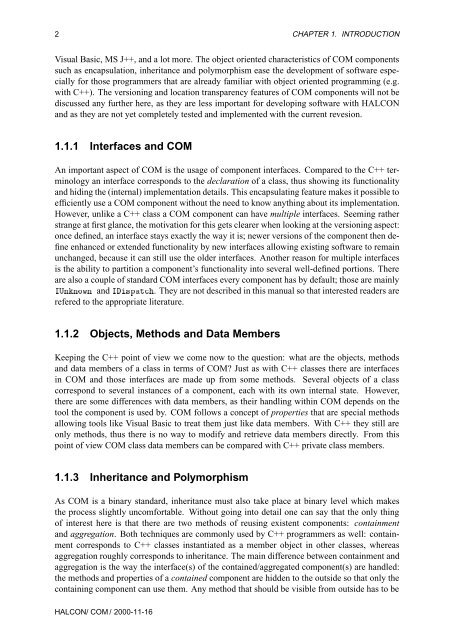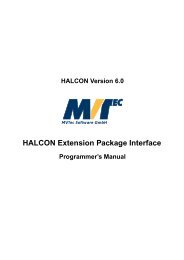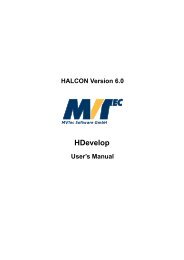HALCON/COM User's Manual
HALCON/COM User's Manual
HALCON/COM User's Manual
You also want an ePaper? Increase the reach of your titles
YUMPU automatically turns print PDFs into web optimized ePapers that Google loves.
2 CHAPTER 1. INTRODUCTION<br />
Visual Basic, MS J++, and a lot more. The object oriented characteristics of <strong>COM</strong> components<br />
such as encapsulation, inheritance and polymorphism ease the development of software especially<br />
for those programmers that are already familiar with object oriented programming (e.g.<br />
with C++). The versioning and location transparency features of <strong>COM</strong> components will not be<br />
discussed any further here, as they are less important for developing software with <strong>HALCON</strong><br />
and as they are not yet completely tested and implemented with the current revesion.<br />
1.1.1 Interfaces and <strong>COM</strong><br />
An important aspect of <strong>COM</strong> is the usage of component interfaces. Compared to the C++ terminology<br />
an interface corresponds to the declaration of a class, thus showing its functionality<br />
and hiding the (internal) implementation details. This encapsulating feature makes it possible to<br />
efficiently use a <strong>COM</strong> component without the need to know anything about its implementation.<br />
However, unlike a C++ class a <strong>COM</strong> component can have multiple interfaces. Seeming rather<br />
strange at first glance, the motivation for this gets clearer when looking at the versioning aspect:<br />
once defined, an interface stays exactly the way it is; newer versions of the component then define<br />
enhanced or extended functionality by new interfaces allowing existing software to remain<br />
unchanged, because it can still use the older interfaces. Another reason for multiple interfaces<br />
is the ability to partition a component’s functionality into several well-defined portions. There<br />
are also a couple of standard <strong>COM</strong> interfaces every component has by default; those are mainly<br />
ÁÍÒÒÓÛÒ and Á×ÔØ. They are not described in this manual so that interested readers are<br />
refered to the appropriate literature.<br />
1.1.2 Objects, Methods and Data Members<br />
Keeping the C++ point of view we come now to the question: what are the objects, methods<br />
and data members of a class in terms of <strong>COM</strong> Just as with C++ classes there are interfaces<br />
in <strong>COM</strong> and those interfaces are made up from some methods. Several objects of a class<br />
correspond to several instances of a component, each with its own internal state. However,<br />
there are some differences with data members, as their handling within <strong>COM</strong> depends on the<br />
tool the component is used by. <strong>COM</strong> follows a concept of properties that are special methods<br />
allowing tools like Visual Basic to treat them just like data members. With C++ they still are<br />
only methods, thus there is no way to modify and retrieve data members directly. From this<br />
point of view <strong>COM</strong> class data members can be compared with C++ private class members.<br />
1.1.3 Inheritance and Polymorphism<br />
As <strong>COM</strong> is a binary standard, inheritance must also take place at binary level which makes<br />
the process slightly uncomfortable. Without going into detail one can say that the only thing<br />
of interest here is that there are two methods of reusing existent components: containment<br />
and aggregation. Both techniques are commonly used by C++ programmers as well: containment<br />
corresponds to C++ classes instantiated as a member object in other classes, whereas<br />
aggregation roughly corresponds to inheritance. The main difference between containment and<br />
aggregation is the way the interface(s) of the contained/aggregated component(s) are handled:<br />
the methods and properties of a contained component are hidden to the outside so that only the<br />
containing component can use them. Any method that should be visible from outside has to be<br />
<strong>HALCON</strong>/ <strong>COM</strong> / 2000-11-16
















